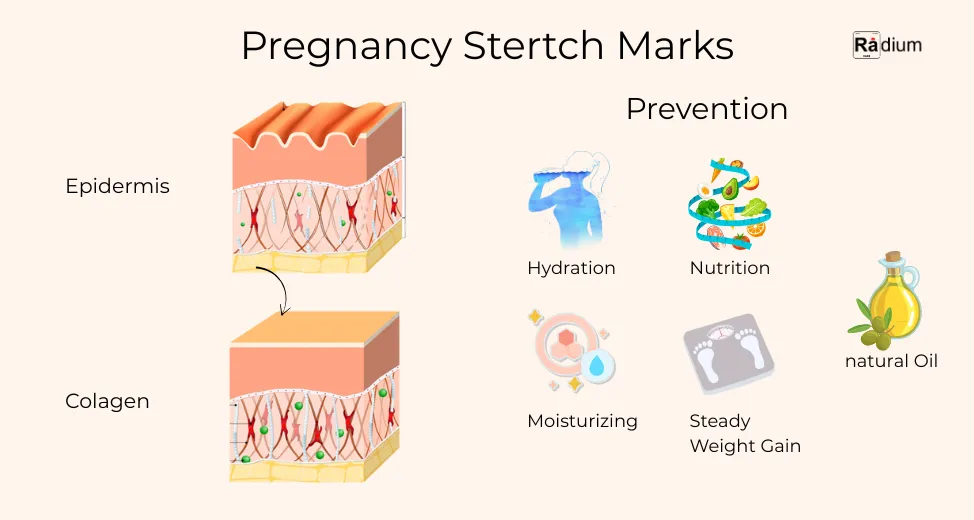Pregnancy will be the most gorgeous and life-altering experience a woman may ever have the pleasure of enjoying. Each week, the body changes, adapts, and nurtures the new life. The experience is a melancholic mix of hope, optimism, and emotional richness. The joy of knowing that first kick, seeing your tummummy expand, and eagerly waiting to see your little bundle of joy is just priceless. But with this divine change are some physical indicators of its omnipresence—one of the most glaring being stretch marks.
Stretch marks or striae gravidarum are most commonly seen on the abdomen, hips, breasts, thighs, and lower back. They appear as your skin stretches fast to support your expanding baby and the accompanying physical transformations. Although entirely natural and extremely prevalent, these marks tend to be wrongly perceived, sometimes even stigmatized, so that most women end up being insecure or uncertain about how they look during and after pregnancy.
In this blog, we explore why pregnancy stretch marks develop, examine their appearance, and discuss natural and medical treatments to minimize their visibility. Most importantly, we hope to offer you emotional comfort in encouraging you to love and cherish the amazing developments happening to you and your body. With careful consideration and industry knowledge, we will accompany you and walk with you as you take this thrilling journey, allowing you to feel educated, enlivened and excited all the way through.
What Are Pregnancy Stretch Marks?
Pregnancy stretch marks, or striae gravidarum, are streaky or linear markings that result as a sequelae of acute skin stretching. While pregnant, the skin stretches out quickly to fit the expanding baby, causing minute tears in the dermis (the middle layer of the skin). When these tears repair themselves, they result in stretch marks.
At first, stretch marks will be red, purple, or brown according to your skin color. They will eventually fade to a lighter color and become less apparent, but may never fully go away.
What Causes Stretch Marks?
When your skin stretches or contracts too rapidly, it hurts the elastin and collagen in your skin. Elastin’s main function is to allow your skin to stretch. The primary role of collagen is to give your skin its structure, strength, and support. In the process of repairing from stretch mark formation, stretch marks are created at the rupture site of elastin.
Are Stretch Marks Contagious?
No, stretch marks are not infectious. You cannot pass on stretch marks through skin-to-skin contact.
Why Do Stretch Marks Appear During Pregnancy?
Many contributing factors cause stretch marks during pregnancy. One of the major causes is genetics. If your mother or sister has stretched marks while they were pregnant, then you are most likely to have them as well. Pregnancy hormonal changes also cause skin susceptibility to tearing. Cortisone, which is a hormone, weakens the elastic fibers of the skin, making the skin less resistant to stretching.
One other contributing factor is how quickly and how much weight is gained. Excessive or fast weight gain increases the risk of overstretching of the skin, particularly in the abdominal and thigh areas. Skin elasticity can also be impacted by the hydration, age, and skin-type of the person. Young skin, for example, may be more prone to tearing but tighter, whereas well-hydrated skin will stretch better. Also, regions of the body that are growing at a higher rate—like breasts, abdomen, and hips—are more prone to stretch marks. While not always preventable, an understanding of these helps women to better maintain their skin while pregnant and work towards expectations with compassion and understanding.

When Do Stretch Marks Generally Emerge?
Stretch marks can start forming at any time during pregnancy, but usually during the latter months, particularly during the second and third trimesters. That is when the stomach begins expanding faster and the skin gets stretched more.
Where Do They Usually Show Up?
The most common places where pregnancy-related stretch marks occur are:
- Stomach (abdominal area).
- Thighs.
- Hips.
- Breasts
- Upper arm.
- Lower back.
- Butt (buttocks)
Depending on where fat is stored or gained during pregnancy, some women can attest to seeing stretch marks on their lower back or upper arms.
Who Do Stretch Marks Affect?
Stretch marks aren’t just for pregnant women. Pregnancy is among the most frequent causes because of the extreme and fast stretching of the skin. Stretch marks are more probable if:
- You pregnant, especially black, spanish, east asian or south asian.
- You rapidly gain or lose significant amounts of weight.
- Your muscles grow quickly through bodybuilding or weightlifting.
- You experience a growth spurt during adolescence.
- There is a history of stretch marks in your family (genetics).
- You have certain medical conditions, for example, Cushing’s syndrome or Marfan syndrome.
- You’ve been taking long-term corticosteroids such as prednisone.
Knowing who is most at risk for stretch marks can help you take precautions early and make good skincare choices.
How to Prevent Stretch Marks During Pregnancy
Chances are you may not be able to stop stretch marks from appearing altogether—particularly if you have a family history—but there are several things you can do to reduce their appearance and keep your skin as healthy and elastic as possible during pregnancy.
1. Keep Hydrated
Drinking a lot of water keeps your skin appearing to be full and retains the natural elasticity of your skin. Dry skin can more easily tear and be damaged.
2. Have a healthy weight
Slow and steady weight gain during pregnancy does not put as much stress on the skin. Follow your doctor’s recommendations for normal weight gain from your pre-pregnancy weight and body composition.
3. Moisturize Frequently
Apply a rich, moisturizing cream or oil body to your hips, belly, thighs, and breasts. Moisturizing the skin will calm the itch response and also act as a protective barrier for your skin. Ingredients like shea butter, cocoa butter, almond oil, vitamin E, and hyaluronic acid are especially nourishing.
4. Eat a Skin-Friendly Diet
Nutrition plays a significant role in skin health. Use foods rich in:
- Vitamin C: Helps to generate collagen (strawberries, bell peppers, citrus fruits)
- Vitamin E: Protects skin cells (nuts, seeds, spinach)
- Zinc: Helps to mend skin and maintain its integrity (pumpkin seeds, lentils)
- Protein: Provides amino acids for elastin and collagen (legumes, dairy products, eggs, lean meats)
Diagnosis and Tests
Stretch marks are easy to diagnose. You don’t necessarily need your healthcare provider to diagnose them.
If you see your healthcare provider, they’ll conduct a physical examination and look over your medical history. If they suspect that your stretch marks are related to Cushing’s syndrome, they will most likely want to do some tests.
Treatment Options for Pregnancy Stretch Marks
Once stretch marks have formed, it’s also helpful to know that they will not entirely fade away, but treatments are usually able to reduce them and improve the overall texture of the skin. The earlier this process happens, the more apparent the results will be, particularly when the stretch marks remain red or purple (referred to as the active phase). Once they progress into silvery or white shades (mature phase), they can get harder to treat—but not impossible.
Topical Creams and Oils
There are a variety of over-the-counter and prescription creams that are actually formulated to diminish the visibility of stretch marks. Look for products with active ingredients like retinoids (not during pregnancy, though, but after delivery), hyaluronic acid, peptides, centella asiatica, and vitamin C. These ingredients act to increase collagen production, improve the elasticity of skin, and reduce color disparities in the skin. Use them every day—most days, twice a day—even for weeks or even months for the best results. Patience and regularity are the names of the game.
Natural Remedies
Most women like natural methods, particularly while pregnant and lactating when reducing exposure to chemicals is a priority. Coconut oil, rosehip oil, and sweet almond oil are antioxidant, essential fatty acid, and vitamin-rich oils that penetrate deeply into the skin and can help improve elasticity. Aloe vera gel, which is highly healing and soothing, also can be used topically on stretch marks in an attempt to soothe inflammation and stimulate repair of the skin. The remedies are gentle, nourishing, and safe for repeated use.
Although natural treatments do not always work dramatically overnight, they promote long-term skin health and tend to leave the skin softer and more pliable.
Dermatological Treatments
In the case of more stubborn or chronic stretch marks—especially those which have been around for a long time—cosmetic dermatological treatment can be considered, usually after giving birth and breastfeeding. Such treatments must always be performed by trained dermatologists or cosmetic surgeons:
- Microdermabrasion: A painless treatment that removes the top layer of skin, stimulates cell turnover, and enhances skin texture.
- Microneedling: Uses fine needles to create micro-injuries on the skin, promoting collagen production naturally and gradually reducing the color and depth of the stretch marks.
- Laser Treatment: Various lasers are used for treating pigmentation and to induce collagen, degrading color and tightening the skin.
- Chemical Peeling: Assist by shedding the surface layer of damaged skin to expose the smooth and soft skin that is beneath.
You should consult a trained dermatologist prior to any of these treatments in order to ensure you can apply the most superior and safest technique to suit your health, postpartum status, and type of skin.
Are There Any Home Remedies?
Some research shows some home remedies may be able to treat or prevent stretch marks:
- Aloe vera gel
- Hyaluronic acid
- Centella asiatica
Massage the product into your stretch marks daily. Results may take several weeks. Consult your provider before use during pregnancy.
Emotional Impact and Body Positivity
Stretch marks are totally normal and highly frequent. Almost 90% of pregnant women get them. But social pressure and media photos tend to impose on us unattainable standards of beauty that get many women feeling embarrassed about their post-pregnancy physique.
It’s also helpful to keep in mind that stretch marks are a testament to the amazing changes that your body made to bring new life into the world. They are proof of strength and growth and love. Accepting these marks as a part of your experience can be a very empowering experience.
Self-care isn’t all products—it’s also being kind to yourself. Treat your body as lovingly as it loved your baby. Whether you decide to treat your stretch marks or use them as a badge of honor for motherhood, the decision is yours, and both are okay.

Caring for Your Skin Postpartum
Your skin will heal and adapt in the long run post-birth. Keep taking care of your skin post childbirth (it will continue to heal and adapt to its new postnatal state) to support recovery and prevent stretch marks.
- Keep moisturizing your skin every day, especially following your showers.
- Protect skin from extended exposure to sunlight to prevent hyperpigmentation of marks.
- Stay well-hydrated and continue to eat a healthy, skin-enriching diet.
- Treat your body gently while it recovers from pregnancy and childbirth.
When to Seek Professional Help
If your skin condition is resulting in distress or further potentially medically-based options, do not hesitate to consult a dermatologist or cosmetic practitioner. They will be able to investigate your skin condition and guide you toward a treatment plan that is consistent with your goals.
Remember, you don’t have to go it alone-there is support available.
Final Thoughts
Pregnancy stretch marks are a normal and natural part of the motherhood experience. They are physical testaments to the elasticity and resilience of your body—the proof that it has been a safe and comfortable home for new life. Though they can be annoying for some women, they are nothing to be ashamed of. With the right care, with patience, and with realistic assumptions, you can improve the health of your skin, and reduce the appearance of stretch marks over a longer horizon.
We truly understand at RadiumCare about the physical and emotional changes a pregnant woman experiences. That is why our personal care line is thoughtfully crafted with moisturizing body lotions, vitamin-enriched creams, and mild cleansers to nourish the suppleness, moisture, and glow of your skin. Our products are formulated specifically to be with you every step of the way, from the initial three months to postpartum, to provide your skin with comfort and care that it needs.
Because your body is worth it at this incredible stage of life. It’s not just about avoiding stretch marks—it’s about embracing every step, every mark, every change, with compassion and confidence.Every mark tells a story. Every story is beautiful. Embrace the journey—you’re doing amazing, mama.
FAQ’s
Que: When do pregnancy stretch marks start?
Ans: They typically occur in the second or third trimester, commonly during the sixth or seventh month, when the skin expands.
Que: Which oils help with pregnancy stretch marks?
Ans: Oils such as argan, bitter almond, lavender, neroli, patchouli, pomegranate, and frankincense may support skin elasticity.
Que: Do pregnancy stretch marks fade after birth?
Ans: Yes, they tend to fade with time, turning from purple or red to pale or silvery but not necessarily disappearing altogether.
Que: Are stretch mark treatments safe while breastfeeding?
Ans: Some of them are harmless, but it is always advisable to take advice from a health expert before using any product.
